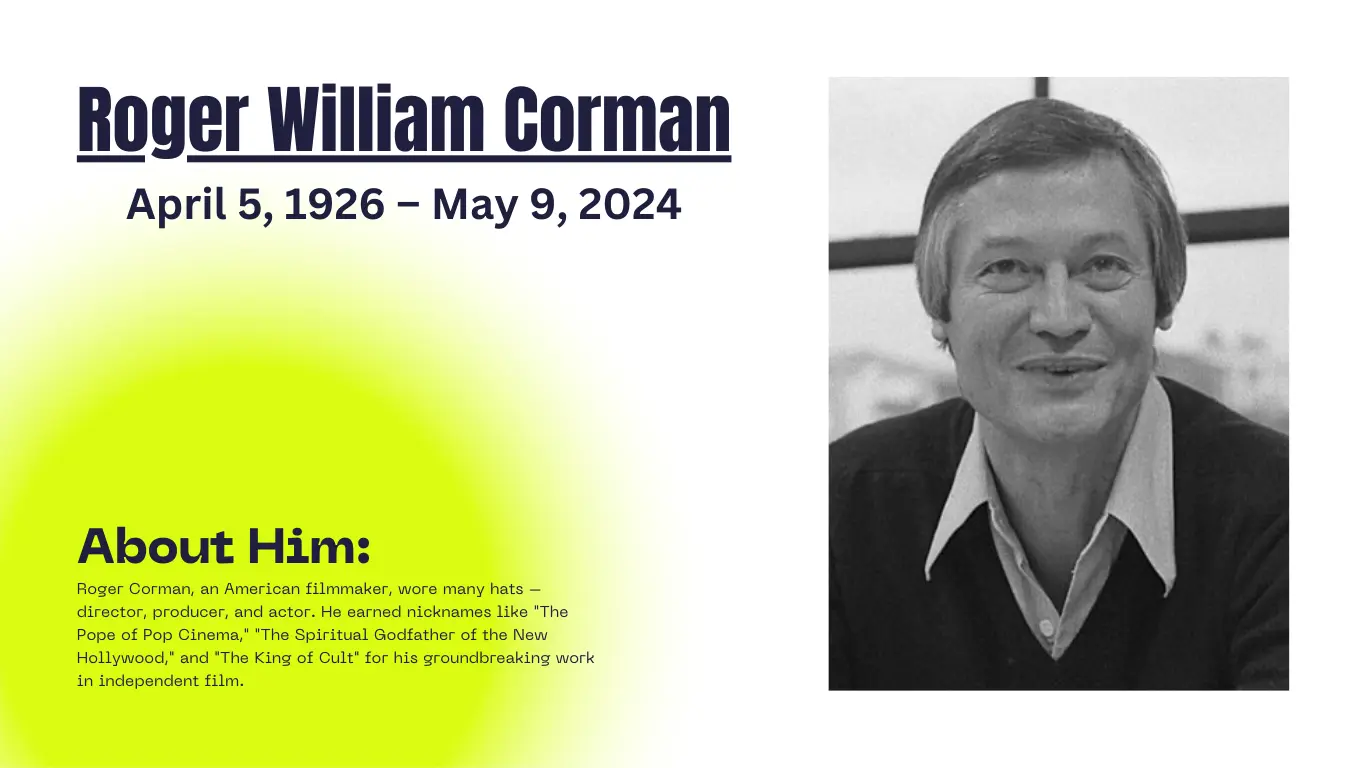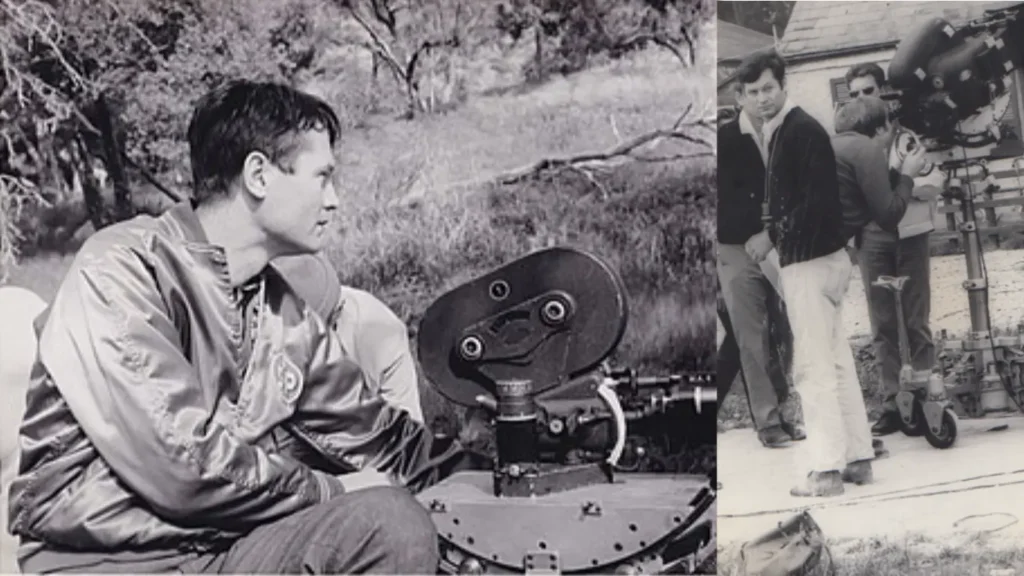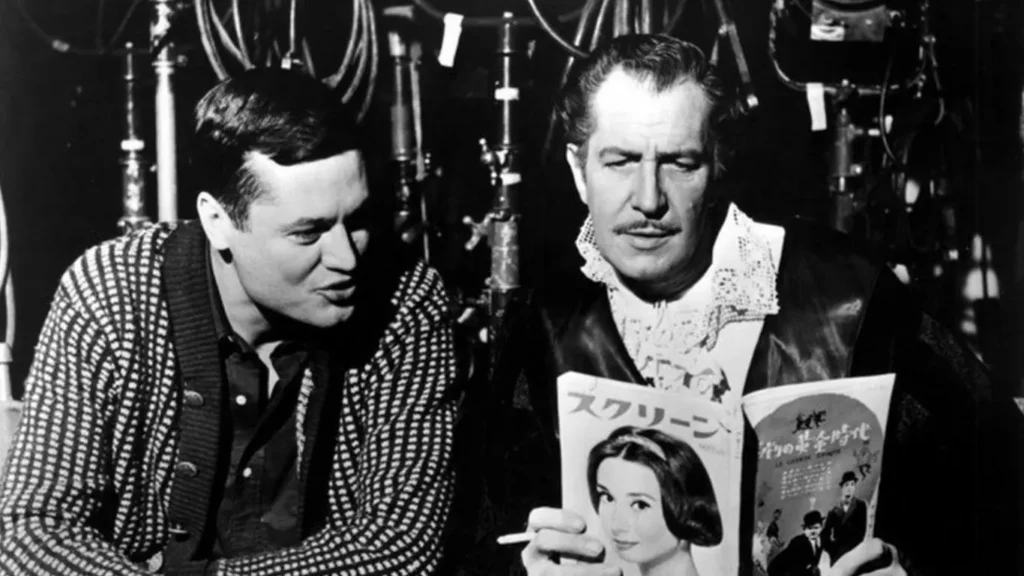Celebrity
American Film Director & Actor Roger Corman Passes Away at 98

Roger Corman, a filmmaker known for making many low budget movies in genres like horror, science fiction, and crime, passed away at his home in Santa Monica, California. He was 98 years old.
Read more about another celebrity died last week in USA.
For decades, Corman was a big name in the world of B movies. He either produced or directed numerous films that didn’t have big budgets but still gained a lot of fans. These movies often had thrilling stories and made on a tight budget. Corman’s work left a lasting impact on the film industry, especially in these niche genres.
His family confirmed Roger Corman’s passing through a statement shared on his official Instagram page on Saturday night.
Roger William Corman was an American filmmaker who worked as a director, producer, and actor. He had many nicknames like “The Pope of Pop Cinema,” “The Spiritual Godfather of the New Hollywood,” and “The King of Cult” because he was a pioneer in independent filmmaking.
Corman was famous for making movies with low budgets that gained cult followings. Some of his films were based on stories by Edgar Allan Poe.

Corman not only known for his own films but also for distributing movies from famous foreign directors. Like Federico Fellini from Italy, Ingmar Bergman from Sweden, François Truffaut from France. And Akira Kurosawa from Japan in the United States.
Corman played a crucial role in launching the careers of numerous young directors like Francis Ford Coppola, Ron Howard, Martin Scorsese, Jonathan Demme, Peter Bogdanovich, Joe Dante, John Sayles, and James Cameron. Corman’s influence extended to the actors he worked with, helping kickstart the careers of stars like Peter Fonda, Jack Nicholson, Dennis Hopper, Bruce Dern, Diane Ladd, and William Shatner. His mentorship and support were instrumental in shaping the New Hollywood filmmaking movement of the 1960s and 1970s.
Corman also occasionally appeared in films directed by those he had mentored, such as The Godfather Part II (1974), The Silence of the Lambs (1991), Philadelphia (1993), Apollo 13 (1995), and The Manchurian Candidate (2004).
A documentary titled Corman’s World. Exploits of a Hollywood Rebel, directed by Alex Stapleton, debuted at the Sundance and Cannes Film Festivals in 2011, shedding light on Corman’s life and career.
The film well received and caught the attention of A&E IndieFilms, who secured its TV rights after a successful screening at Sundance.
Roger Corman’s Early Film Career:
After starting out in the mailroom at 20th Century Fox, Roger Corman gradually climbed the ranks to become a story reader. His enthusiasm for a particular property led to his input used for the film The Gunfighter starring Gregory Peck. But he received no credit for his contribution. Disheartened by this, Corman left Fox and decided to pursue filmmaking independently.
Using the benefits of the G.I. Bill, Corman studied English literature at the University of Oxford and spent time living in Paris. Upon returning to Los Angeles, he struggled to find his footing in the film industry. He took on various jobs, including working as a television stagehand and a messenger at Fox, as well as serving as an assistant to literary agent Dick Hyland.
In his spare time, Corman wrote a script which he sold to William F. Broidy at Allied Artists for $2,000. The script, originally titled House in the Sea but later renamed Highway Dragnet (1954), starred Richard Conte and Joan Bennett. Corman also worked as an associate producer on the film for no pay, simply for the experience.
With the money he earned from selling his script and leveraging his personal connections, Corman raised $12,000 to produce his first feature film, a science-fiction flick titled Monster from the Ocean Floor (1954). The film, produced by Corman’s own company Palo Alto, released by Robert L. Lippert and enjoyed moderate success.
Encouraged by the reception to his debut film, Corman went on to produce another feature, the racing-car thriller The Fast and the Furious (1955). Directed by its star, John Ireland, and co-starring Dorothy Malone, the film caught the attention of producer Neal H. Moritz decades later. Moritz and Universal Pictures licensed the title for their 2001 film, The Fast and the Furious, which spawned a successful franchise. Moritz’s decision to use the title influenced by a documentary on American International Pictures that featured Corman’s film.
Corman sold The Fast and the Furious to a new independent company called American Releasing Company (ARC), run by James H. Nicholson and Samuel Z. Arkoff. Despite receiving offers from other studios, Corman chose ARC. Because they provided upfront funding for him to make two more movies.
Corman garnered his first significant critical acclaim for Machine Gun Kelly (1958). A biopic of the infamous gangster produced by American International Pictures (AIP). This film marked Charles Bronson’s debut in a leading role and also featured actor Cabot. The script penned by Robert Campbell. Another project for AIP was Teenage Caveman (1958), starring Robert Vaughn, originally titled Prehistoric World.

Corman expanded his repertoire by producing two films for Allied Artists. The first, Hot Car Girl (1958), directed by Bernard Kowalski and produced by Corman’s brother Gene, featured a script by Leo Gordon. The second, The Cry Baby Killer (1958), provided Jack Nicholson with his first starring role and was also based on a script by Leo Gordon.
Securing his biggest budget yet, Corman co-produced I Mobster (1958) with Edward L. Alperson and his brother Gene for 20th Century Fox. Additionally, in September 1958, he explored the possibility of filming a remake of H. Rider Haggard’s She in Australia.
Taking advantage of the public interest sparked by the launch of Sputnik. Roger Corman swiftly conceived and shot War of the Satellites (1958), his first collaboration with art director Daniel Haller. He also produced Stakeout on Dope Street (1958), directed by Irvin Kershner. Night of the Blood Beast (1958), directed by Kowalski for AIP, and Crime and Punishment U.S. (1959), directed by Dennis Sanders and featuring George Hamilton in his first lead role.
Decade of Adaptations and Studio Ventures (1960–1969):
AIP approached Corman with a request to produce two low-budget horror films in black and white. Each with a budget under $100,000 and shot within a 10-day schedule.
However, Roger Corman, feeling weary of such constrained budgets and concerned about the declining market for such films, proposed a different approach. He suggested making a color film for $200,000, shot over 15 days. His idea was to adapt Edgar Allan Poe’s “The Fall of the House of Usher,” a proposal that AIP accepted. The project was announced in May 1959.
Richard Matheson was brought on board to handle the adaptation, while Vincent Price was cast in the lead role. Daniel Haller took charge of the art direction. The resulting film, House of Usher (1960), became both a critical and commercial success.
Following the triumph of House of Usher, Roger Corman purchased two scripts, “Sob Sisters Don’t Cry” and “Cop Killer.” In March 1960, he announced that Filmgroup would be joining an international production group, Compass Productions. In August of the same year, Corman directed a peplum film titled Atlas (1961) in Greece.
Although plans for a thriller titled I Flew a Spy Plane Over Russia. Which based on a script by Robert Towne, did not materialize, nor did two comedies titled Murder at the Convention. Pan and the Satyrs, which were to be made with Dick Miller and Jon Haze.
The success of House of Usher led AIP to request a follow up, leading to the reunion of Corman. Haller, Matheson, and Price for The Pit and the Pendulum (1961), another successful venture. Thus, the “Poe cycle” of films was initiated.
Roger Corman also enlisted Charles Beaumont to write Masque of the Red Death and announced plans for two additional films. Captain Nemo and the Floating City and House of Secrets.
End of the Poe cycle and filming in Europe:
Roger Corman ventured to England to produce two more Poe adaptations starring Vincent Price. The first was The Masque of the Red Death (1964), which faced significant delays. Which required script rewrites by Campbell based on Beaumont’s original scripts. Following this was The Tomb of Ligeia (1965), with a script penned by Robert Towne.

Despite these two films being successful, Roger Corman decided not to pursue further Poe adaptations. While AIP initiated a new Poe cycle in the late 1960s, Corman was not involved.
Corman collaborated with Towne on a script titled The Red Baron and also acquired the rights to a Soviet science fiction film, Planeta Bur (1962). He enlisted Curtis Harrington to add additional footage, resulting in Voyage to the Prehistoric Planet (1965). Harrington utilized footage from Planeta Bur in another Corman-financed film, Queen of Blood (1966).
Expanding his ventures, Corman acquired the rights to a Yugoslavian film, Operation Titan (1963). Which financed additional shooting by Jack Hill and Stephanie Rothman. This endeavor led to the creation of Blood Bath (1966). Additionally, Corman invested in beach party films, including Beach Ball (1965) and It’s a Bikini World (1967).
Corman’s Next Venture:
In May 1970, Roger Corman established New World Pictures, a small independent production and distribution studio. The company quickly found success with its early releases, including Angels Die Hard (1970), a biker film, and The Student Nurses (1971), directed by Barbara Peeters.
Another notable hit was The Big Doll House (1971), directed by Jack Hill in the Philippines, which catapulted Pam Grier to stardom. New World Pictures turned a profit of $3.2 million in its first year, with Corman boasting that all eleven of the company’s initial films were successful.
Angels Die Hard sparked a series of biker films, such as Angels Hard as They Come (1971). Which produced by Jonathan Demme, and Bury Me an Angel (1971), directed by Peeters, the first biker movie helmed by a woman. Curtis Hanson made his directorial debut with Sweet Kill (1973), funded by Corman.
The success of The Student Nurses led to a wave of nurse-themed movies, including Private Duty Nurses (directed by George Armitage). Night Call Nurses (1972) (directed by Jonathan Kaplan), and The Young Nurses and Candy Stripe Nurses (1975).
Additionally, The Big Doll House spawned a series of women-in-prison films, including Women in Cages (1972), Black Mama, White Mama (1973), and Caged Heat (1974), the first film directed by Demme.
Corman continued to produce films for other studios as well, such as Boxcar Bertha (1972) for AIP, directed by Martin Scorsese, and Unholy Rollers (1972), which he executive produced.
Despite occasional setbacks like the financial disappointment of Cockfighter (1974), New World Pictures achieved notable successes with films like Big Bad Mama (1974), directed by Steve Carver and starring Angie Dickinson. This success led to a sequel, Crazy Mama (1975), produced by Corman’s wife and directed by Demme.
By 1975, Corman declared New World Pictures to be the most successful independent film company in the country, rivaled only by major studios like AIP. He referred to New World as “the best of the cheap acts,” highlighting the studio’s ability to produce profitable films on modest budgets.
Corman faced criticism for insisting on the addition of a rape scene in Humanoids from the Deep (1980). Similarly, in Galaxy of Terror, he promised investors a sex scene and a gruesome death scene, which were combined into one scene featuring actress Taaffe O’Connell. Despite O’Connell’s initial objections, Corman renegotiated her contract, resulting in her agreeing to the controversial scene.
The massive success of Star Wars inspired Corman to produce New World’s most expensive film yet, Battle Beyond the Stars (1981), which required extensive special effects. To accommodate the production needs, Corman purchased a movie studio in Main Street Venice for $1.5 million. Additionally, he ventured into television with the CBS TV film The Georgia Peaches (1980).
Battle Beyond the Stars proved to be a hit, leading Corman to reuse its footage and music score in other films like Galaxy of Terror (1981) and Forbidden World (1982).
Corman also acquired The Personals (1983), a film that enjoyed success under his stewardship.
Awards, Recognition, and the Enduring Legacy of Roger Corman:
Roger Corman’s contributions to cinema were widely recognized and celebrated throughout his career. In 1964, he became the youngest producer/director to be honored with retrospectives at prestigious institutions such as the Cinémathèque Française, the British Film Institute, and the Museum of Modern Art.
Throughout the years, Corman received numerous awards and accolades for his remarkable achievements in filmmaking.
- In 1964, Corman became the youngest producer/director to be honored with retrospectives at esteemed institutions such as the Cinémathèque Française, the British Film Institute, and the Museum of Modern Art.
- Lifetime Achievement Award at Stockholm International Film Festival in 1990.
- Corman won the first Producer’s Award ever given by the Cannes Film Festival in 1998.
- David O. Selznick Award from the Producers Guild of America in 2006.
- Academy Honorary Award from the Academy of Motion Picture Arts and Sciences in 2009, presented at the inaugural Governors Awards.
- In 2010, Corman was interviewed by writer and actor Mark Gatiss for the BBC documentary series “A History of Horror,” with a focus on Corman during the second half of the second episode.
- Inducted into the Beverly Hills High School Hall of Fame in 2010.
- Honored with the Filmmaker on the Edge Award at the Provincetown International Film Festival in 2012.
- Received the “Extraordinary Contribution to Film” award at the Austin Film Festival in 2018.
Corman was affiliated with various organizations including the Academy of Motion Picture Arts and Sciences, the Producers Guild of America, as well as production companies like New World Pictures, New Concorde, and American International Pictures.
Film elements and prints for many movies directed, produced, and/or distributed by Corman are preserved at the Academy Film Archive as part of the New Horizons Collection. In 2019, the Academy Film Archive restored Corman’s film “The Masque of the Red Death.”
-

 Soccer6 months ago
Soccer6 months agoDutch Fans in Blackface to Imitate Ruud Gullit, One Agrees to Stop
-

 Soccer6 months ago
Soccer6 months agoEx Glamour Model Says Party with England Team Before Euros
-

 News8 months ago
News8 months agoDubai Flood, Rain Turns Desert to Aquarium🌧️🐠
-

 Soccer6 months ago
Soccer6 months agoArgentina vs Peru 2-0 Highlights & All Goals Copa America 2024
-

 Entertainment7 months ago
Entertainment7 months agoThe Try Guys’ Journey From Four to Two
-

 NBA6 months ago
NBA6 months agoCelebrate with the Boston Celtics: Parade and Traffic Updates
-

 Soccer6 months ago
Soccer6 months agoUEFA EURO 2024: Essential Guide and Key Information
-

 Soccer6 months ago
Soccer6 months agoVinicius Jr Scores Two Goals in Brazil’s Win Vs Paraguay in Copa America 2024













